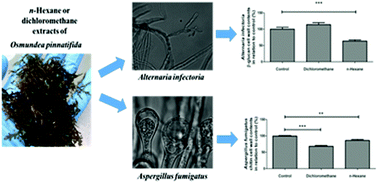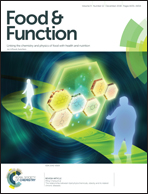The antifungal activity of extracts of Osmundea pinnatifida, an edible seaweed, indicates its usage as a safe environmental fungicide or as a food additive preventing post-harvest fungal food contamination
Abstract
In the present work, we explored the antifungal activity of the wild edible seaweed Osmundea pinnatifida (Rhodophyta) collected from the Portuguese coast, which is used as a food seasoning in Scotland, Ireland and Portugal. We performed a sequential extraction of the seaweed components with methanol, dichloromethane and n-hexane. These extracts showed an antifungal activity against Alternaria infectoria and Aspergillus fumigatus. The n-hexane fraction of the seaweed inhibited the sporulation of Alternaria infectoria at 30 μg mL−1 and induced a statistically significant (P < 0.001) decrease in β-glucan content. Furthermore, liquid cultures of Aspergillus fumigatus supplemented with 10 μg mL−1 of the n-hexane fraction showed abnormal conidiophores, completely devoid of phialides and conidia associated with a decrease of 18.3% in the chitin content (P < 0.01). The n-hexane fraction analysis by GC-MS revealed that it includes palmitic acid (29.6%), phytol isomer 1 (12.8%), oleic acid (9.6%), stearic acid (6.2%) and D-(−)-tagatofuranose (4.1%), among other compounds present at lower concentrations. The present study reveals Osmundea pinnatifida as a promising source of biologically active compounds inhibiting fungal growth and conidiation, the main dispersal mechanism of filamentous fungi as Aspergillus fumigatus and Alternaria alternata, revealing its utility both as an environmental fungicide against fungal diseases and as a food preservative against fungal post-harvest food contamination.



 Please wait while we load your content...
Please wait while we load your content...